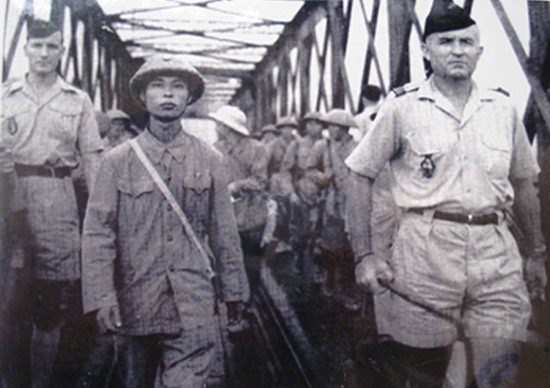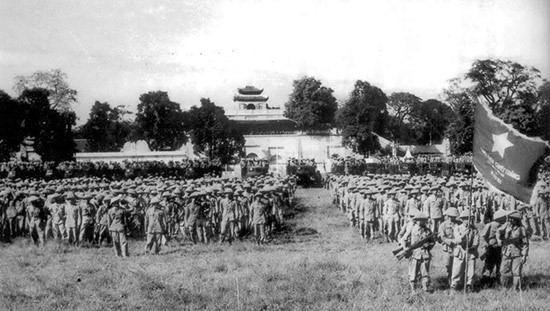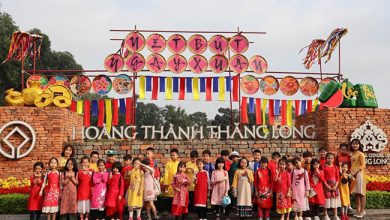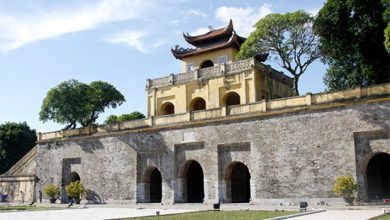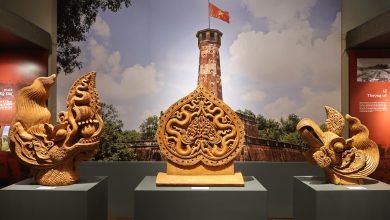Remember the historic returning day in 1954
Not to carry out combat in Hanoi but Hanoi was liberated, it is the wonderful victory thanking to the ingenious leadership of the Party and the President Ho Chi Minh, strategic ability and astute tactics of the General Vo Nguyen Giap, the sacrifice of all people with the great achievement: “Nine years fighting resulted in the glorious and historical Dien Bien Phu victory”.
Sharing the memory about Capital Liberation Day, October 10th 1954, the Lieutenant-General Pham Hong Cu, Former Deputy Political Commissar of Regiment 36, Brigade 308 said that: “for all people, that day was Hanoi’s Liberation Day but for us that was the day of historic return”.
The Commissar of Binh Ca Battalion Vu Huy Hau went across Duong bridge to Hanoi on 8 October 1954. Photo from Archives
Leaving with an appointment to return
The first generation of Capital Regiment after 60 days and nights of fighting “Die for the motherland to live” to protect Hanoi Capital, who have successfully carried out the miraculous withdrawal, preserved its forces for long term fighting.
Leaving the Capital, all officers and soldiers of the Regiment were deeply tormented by the nostalgia to Hanoi.
“The soldiers were garrisoned in the deep forest
having dream tonight to return to Hanoi
When to return?
Olden roads full of tegular bricks
Tonight they miss their home
With the walls fell to pieces
Miss the night they left when fire blazing up
The whole capital was in fire after their backs …”
In 1947, Chinh Huu, the poet of the Regiment wrote above poem and Luong Ngoc Trac, musician of the Regiment set the poem to music. Together with other songs such as Soldier’s life in dream, Long-march song, the song Return day (music: Luong Ngoc Trac, poem: Chinh Huu) has reflected the exact state of our mind on that day. Everyone dreamed of a return day and in our imagination, return day would be a drastic fighting.
Chinh Huu wrote:
Polish guns, wipe swords, eyes flashing
A ha! Dilapidated houses and collapsed roofs
The roads were filled up with dead bodies
Old tegular bricks welcomed their old owners
Walking in deep resentment trampling down the enemy …
And on 10th November 1954, as the advance unit, Brigade 308 was led by Capital Regiment to take over Hanoi. The Capital Liberation Day took place the same way in imagination of the well-known musician Van Cao who composed the song “Returning to Hanoi” in 1949:
Innumerable victor soldiers as waves after waves overflow
Troops after troops returning
We are very happy seeing enemy surrender
Flag rising in streets on that day
Our troops are marching and singing
An bayonets glittering
We returned with victory and glory
Our happy life has already started
Five city gates welcome the return of soldiers
…
Capital Liberation Day was taken place as a festival. Not to carry out combat in Hanoi but Hanoi was liberated, it is the wonderful victory thanking to the ingenious leadership of the Party and the President Ho Chi Minh, strategic ability and astute tactics of the General Vo Nguyen Giap, the sacrifice of all people with the great achievement: “Nine years fighting resulted in the glorious and historical Dien Bien Phu victory”. (To Huu).
Historic Dien Bien Phu victory led to the liberation of the North and Hanoi Capital.
With the badge “Soldier of Dien Bien Phu” worn on the chest, the soldiers of Capital Regiment returned to their city where their Regiment was established. October 10th 1954, for all people, that day was Capital Liberation Day but for the Regiment that was the day of historic return which our generation has dreamed for a very long long time of the resistance war against French colonialism. And the return day was to come.
According to the provisions of Geneva Agreement 1954 and Trung Gia Conference signed by Armistice Committee, Hanoi within 80 days, and Hai Phong within 300 days for French troops to withdraw.
On October 8th 1954, exact 80 days after signing of Geneva Agreement (20/7/1954), Binh Ca battalion (Capital Regiment, Brigade 308) under the name of a guard unit which was the first army unit marching to Hanoi to take over 35 military bases of French troops, a delegation of more than 200 civil officials led by Mr. Tran Danh Tuyen marched to Hanoi on October 2nd 1954. On October 8th 1954, French expeditionary force lowered their flag. On October 9th 1954, French troops began to withdraw from Hanoi. The places where French troops had just withdrawn were taken over immediately by our troops. Until 16: 30 on October 9th 1954, the last French troops left Hanoi across Long Bien bridge. On October 10th 1954, our great troops marched to the city with the warm and jubilant welcome by Hanoian people.
The event that Binh Ca Battalion honored to be appointed as the first military unit to take over Capital was the historic coincidence of rare occurrence as it was the first unit left Hanoi on the date beginning National Resistance (1946). The veterans of Binh Ca Battalion are very proud of its unit as the historic witness of both historic events leaving and returning.
Binh Ca Battalion is the first unit who realized the oath of the Capital’s soldiers “Leaving and appointing a day to return”.
The generation of the first officials and soldiers of the Battalion were militia who took part in Capital protection from the date beginning National Resistance (19/12/1946), under the order to withdraw before 14/1/1947, gathered in Ha Bang (Son Tay), established the Battalion with the designation 42, received the order to operate to Viet Bac, control Binh Ca ferry, block up Binh Ca ferry protecting the western gate of Safe Zone where the national resistance was led by the Central party committee and Government. In October 1947 when French troops opened a big attack to Viet Bac, the Battalion gained victory in the first battle in Lo river and then bore the title “Binh Ca Battalion”. Who those experienced from Tuyen Quang to Thai Nguyen during resistance period will not forget “Binh Ca ferry with waves were lapping” (poem by To Huu). Today, at this ferry is an impressive Statue of Victory has been built with the praise by the General Vo Nguyen Giap: “Binh Ca battle, Battalion 42 fought off the troops landed, seized their guns, shot and made their boats full of artillery sunk, made the first feat of arms, began the following glorious victories in Lo river”.
In Binh Ca battle, I was the first Commissar of the Battalion, and when took over Capital, Mr. Vu Huy Hau was the last Commissar in the resistance against French troops. Mr. Hau and the Battalion marched across over Duong bridge and took over the Capital on 8/10/1954.
The people raised the flags, threw flowers, crew over triumph and welcome the troops marching to liberate Capital on 10/10/1954. Photo from Archives
Before marching to Hanoi, the officials and soldiers were fully aware of the task: to take over the bases of French troops, protecting and acting as supports for the revolutionary bases and Hanoian people to struggle against terrorism, robbery, acts of sabotage, ensuring safety for Brigade who would liberate Capital on 10/10/1954, ensuring the normal life of the Capital, especially electricity and water. The officials and soldiers discussed the specific measures to be taken, strictly preventing any conflict, raising high spirit of revolutionary vigilance, to be self-controlled, clear-sighted, preventing being provoked by the enemy which all might exert negative influence on the implementation of the Agreement.
The Battalion chose 215 among more than 400 officials and soldiers, divided into 35 groups to take over 35 French bases. Each group had at least 3 soldiers, the two groups appointed to take over electricity and water factories had 13 people each led by head of Brigade 261 cum commissar.
In the morning of 8/10/1954, the Battalion marched to Duong bridge. GMC cars and 3 armored cars of French party transported our troops to Armistice Committee located at Don Thuy Hospital (Military Hospital 108 now). In all meetings, as the victors, we took initiative in creating friendly atmosphere, shouting slogan “ Vive la Paix”. The initial strained and suspicious atmosphere was dispelled.
In the evening of 8/10/1954, Mr. Hau inspected the bases driven by a French driver on a Jeep. Our military car, Molotova, transported rice, water supplied to the comrades. All the afternoons until curfew time (22:00) only half of bases were supplied, after that bread were used with dispatch. In the afternoon on 9/10/1954, Mr. Hau went to carry out inspection once again. Generally, it was quiet, only some places the comrades struggled with the hostile forces.
At the Bac Viet Police Station and Supreme Court, with the reason of security, French party arranged our comrades in the very closed position, making difficult to observe, we struggled and forced them to arrange our comrades in other place. The most worrying thing is Yen Phu water factory, hostile piled around the well with many white powder bags which we suspected as poison, we discussed in secret with the our soldiers to prevent this and after all hostile had to remove these bags. At Hang Voi station, the legionnaire drunk and asked to deprive our guns. The situation was better thanking to the timely intervention by the responsible officials. At Ngoc Ha artillery station, the hostile destroyed our military quarters, Mr. Thanh Tung who can speak French made explanation end they ceased the destruction. At Hanoi railways station, our soldiers were in coordination with the workers to stand guard over all positions in the station all day and night preventing the hostile from any act of sabotage.
In addition to protection, our comrades also took initiative in meeting and carrying our propaganda among enemy troops by many ways such as arranging flower at the head of gun with a view to expressing good faith, looking at the photos of their wives and children and gestured them to return to their country. Those who know French spoke: “Paix! Rapatriement!”. The enemy troops were frightened by our soldiers singing: “Heroic soldiers ready to the battlefield …”, “Self-sacrifice for the people”. The French official told Mr. Hau: “Only in two days, Hanoi would belong to you. Please stop singing”.
During two days jointly on the watch with French party, Binh Ca Batallion protected all 35 bases in safe condition. During two very strained days, some officials and soldiers were hungry, however, the Battalion consistently outperformed their duty “see” French troops out, welcome the Brigade to liberate the Capital. The normal life of Hanoi was still in good order: tramcars still run with tinkles, water keeps flowing, electricity exists in every family … That was the feat of arms gained by the revolutionary bases inside Hanoi and by the officials and soldiers of Binh Ca Battalion.
Photo from Archives – Brigade marched into Hanoi
At 5:00 in the morning of October 10th 1954, when curfew had finished, the whole city became animated. The Church opened to welcome the new day, Capital Liberation Day. The streets were decorated with so many flags, banners, slogans and welcome gates. All people were well dressed with the most beautiful clothes, streets and roads were well – arranged and clean to welcome the victorious army.
At 8:00 a.m, all units of Brigade 308 were in military uniforms with the badges “Soldier of Dien Bien Phu” worn on their chest returning in the arms of Hanoian people with a forest of flowers and flags and their warm welcome.
The army hero Nguyen Quoc Tri, the Head of Capital Regiment and Mr. Tran Dong, the Head of Battalion 54 led the infantry troops to march from Mai Dich through Cau Giay, Kim Ma, Hang Day, Cua Nam flowers garden, Hang Bong, Hang Gai to Bo Ho, through Hang Dao, Dong Xuan market, Hang Dau, Cua Bac and marched to Hanoi.
From the South, another infantry troops including Tu Vu Regiment and Brigade led by Mr. Tu Vu, the Head of Tu Vu Regiment started from Vietnam campus to Bach Mai, Pho Hue through Trang Tien and heading to Don Thuy.
After infantry was mechanization troops. More than 100 new grass-green Molotova cars with the insignia containing red flag with yellow star painted in their doors following one another slowly driving to inner city. In the cars, the soldiers sitting in well-balanced position, their rifles leaning on floor board, bayonets were glittering.
The mechanization troops were led by the convoy of command cars. In the first car, the Major General Vuong Thua Vu, the Commander of Brigade 308, the Chairman of the City Troops Committee raised his hand to greet the people. Following was the car of Doctor Tran Duy Hung, Vice Chairman of the City Troops Committee, and next was the car of the comrades belonging to High Command of Brigade, who were political commissar Dong Hao, Vice Head of Brigade Cao Van Khanh.
Following Molotova cars was artillery troops. The antiaircraft gun batteries with the gun barrels rising to the sky and the soldiers sitting seriously in the battery platform.
The troops were marching with the shouts for joy like waves rising. The streets were full of flags and crowds whose faces radiant with smile, their hand waving and the tears.
At 15:00 p.m on October 10th 1954, the historic flag saluting ceremony was officially held. Photo from Archives
Historic flag saluting ceremony
The historic flag saluting ceremony was held in the afternoon on October 10th 1954. The victory flag of motherland was waving on top of flag-tower. Hanoi’s autumn sky was blue decorated by vermilion color of the flag like a flower.
In the Manzin stadium (Cot Co stadium now), the units who participated in the flag saluting ceremony gathered in their groups in good order. First row was infantry troops including Capital Regiment, representatives of Brigade 308, Regiment 57 and Brigade 304. The Head of Battalion 54 – Suicide squad of Hanoi in the winter 1946 was appointed make report to Mr. Vu Yen, the Chief of Staff of the Brigade.
Following the infantry troops were mechanization and artillery troops in very straight rows with cars and guns, gunners and infantry soldiers standing at attention on the cars.
Around the stadium were people flocking from the urban wards, making Hoang Dieu and Cot Co (Dien Bien Phu now) streets so busy. Everybody wanted to be present at that historic flag saluting ceremony.
At 15:00 p.m when siren from Opera-House was sounded the whole city were directed toward Hoang Dieu citadel.
The flag saluting ceremory was chaired by the Major General Vuong Thua Vu and Doctor Tran Duy Hung. The Military Bank under the direction by the Bandmaster started the national anthem. Everyone in deep respect directed to the national flag rising on top of Cot Co tower. When the music had just ceased, the Major General Vuong Thua Vu, the Chairman of the City Troops Committee stepped out in front of the louderspeaker and read the Appeal of the President Ho Chi minh sent to the Capital’s people.
Opened the Appeal, Uncle Ho wrote: “Over 8 years have elapsed, the Government has left the Capital to carry out the war of resistance to save country. Although we were far the Government are always side by side with the people. Thanking to our peoples’ solidarity, our military troops’ braveness, we won victory and live in peace, Government returned to Capital and people. We all are of the same house with indescribable joy and happiness”.
Uncle Ho gave his regards to the people in informal manner and recommended: “After substantial changes, the recovery of the normal life will be difficult and complicated. However, the Government will be determined and try its best, all Hanoian people agree to contribute their part together with the Government, we will definitely overcome all difficulties to achieve the target making our capital peaceful, jubilant and prosperous”.

